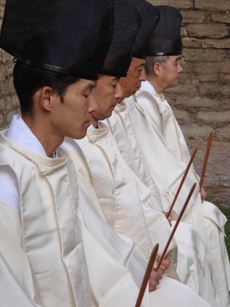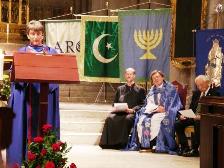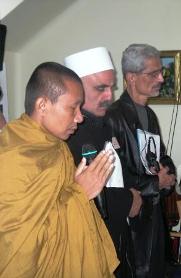| |
|
 |
Millions of hectares of religious forest managed ecologically by 2014
September 18 2007:
 |
 |
 |
The Association of Shinto Shrines has invited participants to launch the Religious Forestry Standards at Ise 2014. |
The inaugural Faiths and Forests meeting in Visby, Sweden culminated in August 2007 in a unanimous agreement to go forward and create a Religious Forestry Standard.
Once accepted, it will cause millions of hectares of forests around the world to be managed according to religious, environmental, social and economic criteria.
The plan is that between 2007 and 2014, a series of regional gatherings will be undertaken in Europe, Asia, Africa and the Americas. These will be fed in to the proposal, culminating in the launch of an agreed International Religious Forestry Standard at the most sacred event in Japanese religious and social life: the rebuilding of the Grand Shrines at Ise.
There was also a decision to proceed further on the Sacred Sites programme – with the aim of making “Sacred Sites” an internationally-recognised term.
BackgroundOne of the more extraordinary outcomes of the WWF/ARC Kathmandu Sacred Gifts programme in 2000 was the creation of a unique partnership between the Jinja Honcho Association of Shinto Shrines of Japan and the Church of Sweden. In a joint declaration they suggested that all faith-owned forests should be run on ecologically sustainable and socially just lines and they requested ARC to work to achieve this.
 |
 |
 |
The President of Visby Cathedral, Inger Harlevi, welcomes the faiths, along with Chairman Kuni of Jinja Honcho, Bishop Lennart Koskinen of the Church of Sweden and Martin Palmer of ARC at the Opening Ceremony. |
Such a revolutionary new partnership, especially unusual for the Shinto, led to much discussion and debate and it was in 2005 that this partnership really began to take off with joint meetings and discussions held at the invitation of the Shinto.
In 2006, a joint team from WWF, ARC, the Church of Sweden and FSC, funded by WWF-UK, undertook a study tour of some of the major Shinto owned forests in order to better understand the Shinto perspective on both sacred sites and forests.
As a result of this visit and subsequent meetings and discussions, Jinja Honcho made the generous and previously unheard of suggestion that at the grand ceremony for the rebuilding of the Great Shrines of Ise, Japan’s holiest site, surrounded by a magnificent forest, Jinja Honcho would invite all the major forest owning religions to attend. The ceremony takes place in 2014.
The reason would be that all those attending would have signed up to a religious forestry standard which would be formally launched as a world wide development at that time. In return, the Church of Sweden proposed that they host the first event, starting off the road to Ise. This was that meeting. Link here for the press release.
The attendeesThe gathering brought together owners and managers of religious forests, from Buddhism, Christianity (Catholics – the Benedictine movement; Lutherans; Maronites and Orthodox); the Druze tradition; Hinduism and Judaism. The basic aim of the gathering was to ensure that all such forests, forest lands, watersheds and habitats could be managed to the highest religious, social and ecological standards.
We were joined by secular partners specialising in forestry issues from The Christensen Fund, Conservation International, FSC, IUCN, UNDP and WWF Sweden. Swedish Government representatives also joined us at various stages.
 |
 |
 |
Ven Hiek Sopheap from the Association of Buddhists for the Environment in Cambodia, with Sheikh Sami Abilmona of the Druze tradition, and Monsignor Camille Zaidan of the Maronites |
Inspired by, yet different from FSCWhile inspired by the example of FSC, it was also recognised that FSC was designed to counter a rapacious commercial market and not for traditions who have often owned the forests and who have had a sacred relationship with the land for centuries. We needed to create a Standard that would reflect the very different circumstances and nature of such forests but which would also help the faiths to creatively manage them to the highest environmental and social standards.
The Visby meetingA range of papers were presented covering the theology of forests in each tradition; including practical projects from Tanzania, to Cambodia to Romania; new initiatives such as the Church of Sweden’s project with the Mozambique Churches to reforest over 100,000 hectares; scientific insights; management suggestions; stories and legends; rituals and ceremonies associated with forests and economic perspectives.
The Visby celebrations
The 12th century cathedral of Visby provided a setting for two celebrations featuring all the faiths and the event was closed by a Shinto ceremony in the ruins of a medieval church by kind permission of the diocese. Each session opened and closed with prayers and meditations about forests from different traditions and these have been added to the website, as so many people found them helpful and thoughtful. Link here for a story in Swedish from Miljö Aktuellt.
The Religious Forestry Standard: the next Six YearsARC agreed to draw up a six year timetable and set of milestones to be discussed with all the participating faiths and to be guided by the steering group of the three founding organisations, namely Jinja Honcho, The Church of Sweden and ARC. This document is currently being prepared. We are very grateful to The Pilkington Foundation and WWF UK for supporting the funding of this event along with the Church of Sweden.
“The protection and proper management of the vast quantities of religiously owned forests – along with their associated watersheds and animal habitats - is a visible signs of the growing role of faiths in protecting the environment in line with their own teachings,” said ARC’s secretary general Martin Palmer. “It is also one of the most specific ways of helping tackle climate change and CO2 emissions.”
Also: the Sacred Sites Programme and the ancient meadows of GotlandThe issue of protection of sacred sites revealed a fascinating difference in theological and therefore psychological understandings of sacred sites. In the Abrahamic traditions, protecting nature is a natural outcome of the notion of people’s role before God as guardians, stewards or priests of creation. However for other traditions, notably Hinduism and Shintoism, it is we who should recognise that we are protected by nature.
This led to an agreement that ARC should undertake work to help each major tradition to define its own theology of sacred sites, and in particular to outline their position on respecting and protecting those sites that are either sacred to other traditions and/or which they share with other traditions.
ARC is now in active discussion to develop this idea into a formal programme incorporating alongside this the commitments made with WWF International at the World Parks Congress in 2003 to have sacred sites agreed as a term of international protection and the development of a sacred sites programme with UNDP. Meanwhile, new sacred sites are being declared as protected or cared for and during the meeting the Church of Sweden declared that the endangered meadows of Gotland, of which the Church owns the majority, would now be classified as Church of Sweden Protected Environments.
|
 |
 |
|
|
|
|
|
 |
Religious Forests
Sacred woods, forests and trees are found in all the major religious cultures of the world. The tree forms a fundamental part of the mythology of many faiths, from the Tree of Knowledge in Judaism and Christianity’s Tree of the Cross to the sacred trees of Hinduism.< |
 |
October 19, 2010:
Religion and biodiversity in Ethiopia's sacred forests
Ethiopia's sacred forests, where land protected by churches and their communities are a vital conservation refuge for many species of plants and wildlife, have been highlighted on a BBC radio programme looking at faiths and biodiversity. |
 |
 |
|
|

